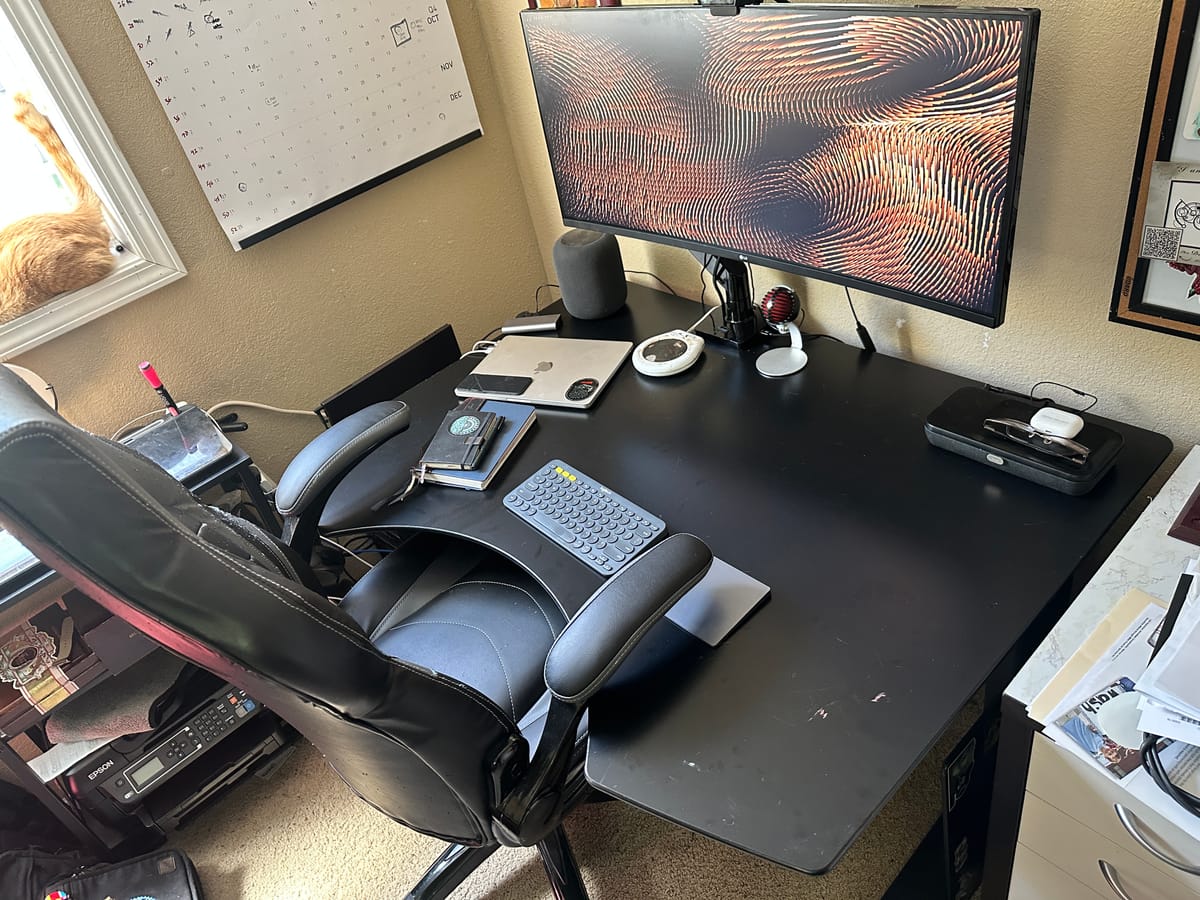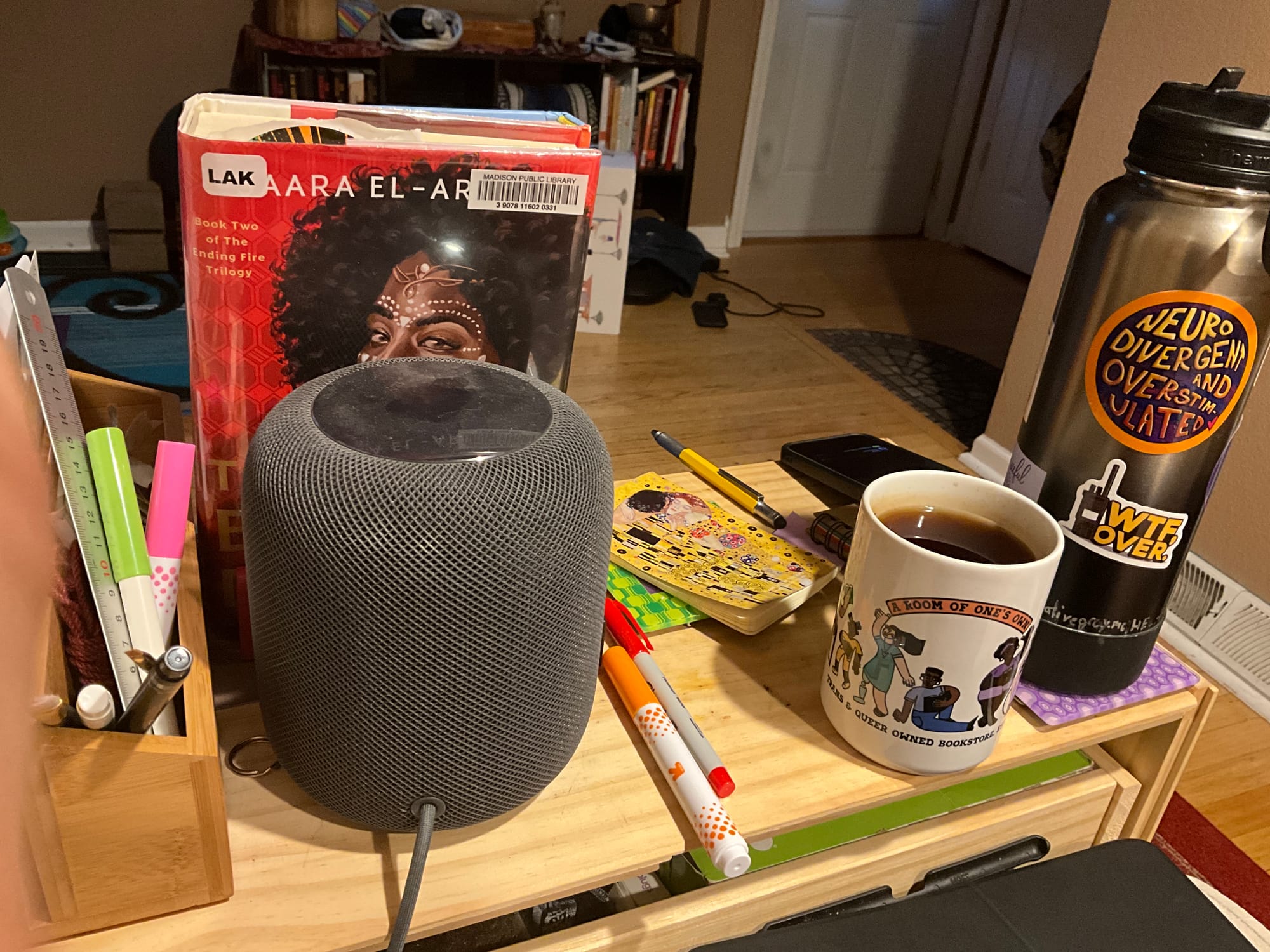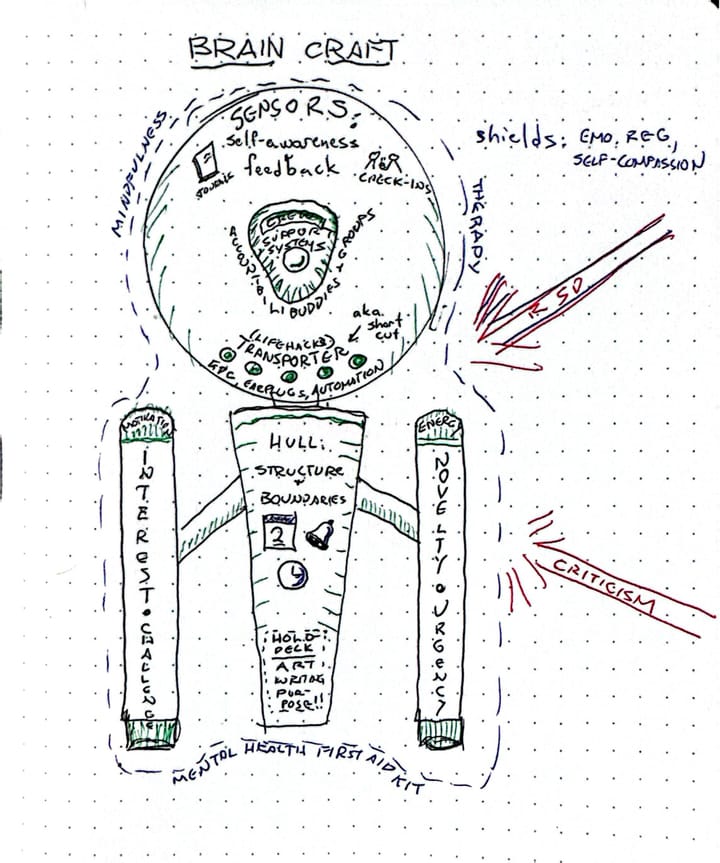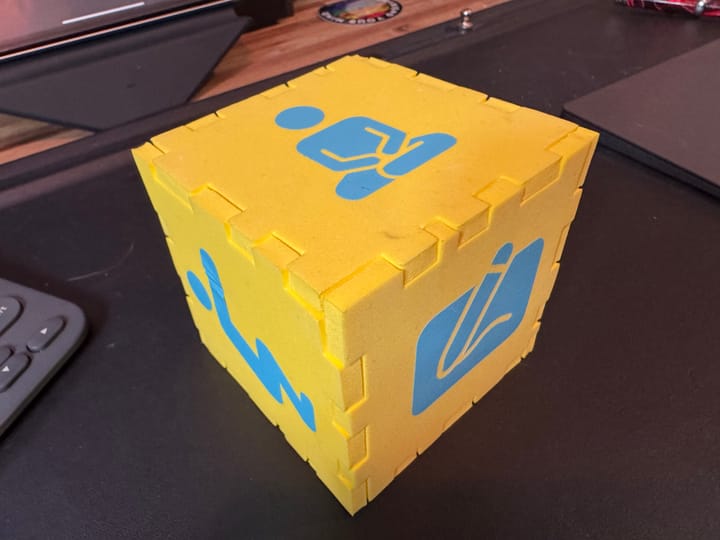How to Keep Chaotic Clutter from the Trap of Horizontal Surfaces.

Tables, desks, counters — they are magnets for the detritus of life. This is how you fight back.
Look at your desk. Or your dining room table. Or the end table next to the couch you’re sitting in.
Here, I’ll show you mine:

Pretty cluttered, right? And it is not as bad as it could have been — I removed a personal item from the collection before taking the picture. If the horizontal surfaces in your life resemble this, then you’re in the right article.
If not…well, gee, it must be nice to be you.
I’m not actually certain that it’s a quality of ADHD, but there is something about a plane set parallel to the ground that makes me want to fill it. It might be decorating it in a tasteful minimalist accent, or making it “useful” by putting things on it that I’m convinced I’ll use. At first it seems fine — but at some point I’ll walk in the door with my hands full, and I’ll put something down on it, fully intending to “put it away” later. Or I’ll be straightening up some other room and put something there as an “interim staging area” because wherever the thing belongs is obviously too far to walk*
I almost think it’s nature’s counter (ha!) to the predilection of cats to push things off of tables…
The Good News is: People Have Thought About This.
This balancing act between anxiety and efficiency is not Marie Kondo-level decluttering. Trust me, I’ve not only done it, I speak as possibly the only Marie-Kondo Certified Good Boyfriend (a strange but true story for another time).
I’ve also tried just not having horizontal surfaces — which simply means you get piles on the floor.
Drawing from several different design and efficiency experts both online, in books, and from my own varied histories, here are three things that I have found give me some success in not drowning in stuff:
1. Make a Stuff Zoo. No, sorry, not a “stuffy zoo” (that’s completely different) but when you are storing your things, think about the zoo aesthetic: I want to be able to see it, but I don’t want it to be able to escape. Adam Savage calls this the “shelves not drawers” mentality: drawers are “…where objects in your shop go to get lost and never be used.” Meanwhile, shelves give what he calls "first order retrievability," the gear is both visible and where it belongs.
Clear bins work well for this, as do wire baskets. I’m playing with the idea of taking cigar boxes I like and removing the lids (or creating a clear acrylic or latex one) to suit my own aesthetic.
bonus tip: Marie Kondo used to recommend an animistic questioning of each item, asking it where it wants to live. I think a better way to do this is to to borrow from Maurice Moves idea of “Urgency Zones”. It sounds panicky, but he just means you put the things you use most in the easiest-to-access places. I’m still working on implementing the idea, but I did move my phone/watch charger, wallet tray, and box with all my important IDs and cards to the top shelf right inside my office doorway — and it has made a difference in knowing where things are when I need them.
2. DOOMbin & Scheduled Resets: One of the issues I’ve always had with the “a place for everything and everything in its place” mindset is that it doesn’t allow for spontaneity. Maybe I’ve taken my bedside book into the office. Maybe the sketchbook and markers ended up in the living room while I did body doubling with my partner. The idea that I will always have the time, energy, and attention to put something back right when I’m done is not realistic.
Enter the DOOMbin. “Didn’t Organize. Only Moved.” It’s a basket — maybe one in each room, but you’ll know where you need them — where you are allowed to put things when it’s not convenient to put them where they belong. It’s an acknowledgement that the flow of life doesn’t always match up with putting things away.
But things do need to go to their homes eventually, so there are two rules for DOOM bins:
- there is a scheduled time each week — whether that’s Friday afternoon, Sunday morning, whenever — that you will tackle the stuff in the DOOMbin and put it in its rightful place. Do it while singing out the battle cry: “EMPTY THE DOOMBIN!”
- If the DOOMbin is full — and you know what that looks like, don’t try to turn it into a Tetris/Jenga hybrid — then you set the timer for five minutes and take that time to put away as much as you can. It’s up to you to decide if, after five minutes, you want to continue. I won’t make you. You’re an adult; do what you like.
- Externalize. Externalize. Externalize. Every chance you get to avoid making a decision or taking an action, do it.
- Tasks don’t live in an app that you have to decide to check: put them on postits on the wall
- Don’t make yourself choose to do yoga in the morning — put the mat out between you and your coffee so that you trip over it right into child’s pose. While you’re there, might as well do a few more poses before you get up, amiright?
- With a reluctant nod to Atomic Habits dude, you can chain objects to habits as well. For example: my partner has to remember to take meds in the morning. She also often misplaces her glasses. She came up with a brilliant externalization: at night, before bed, she puts her meds and her glasses on the counter right next to each other. If she’s wondering why she can’t see, when she finds her glasses she will remember to take her meds. Or if she goes into the kitchen to get coffee, she first runs into her meds (applying the above trick) and also doesn’t have to wonder where her glasses are.
While it’s still up for debate whether or not willpower is really a finite source, we know for a fact that it often feels like one. The more willpower you save by not having to wonder where things are, or where they belong, the more likely it is that you’ll have the won’tpower for things like “No thank you, I don’t want a donut — pass me an orange?” and other sad things.
Don’t Be Pinteresting.
Above all, the biggest thing that has helped me escape the chaos that my office/shelf/workshop sometimes leans towards is to simply embrace it.
Yes, I enjoy the organization porn of sites like Pinterest and Reddit, even before they started getting swamped with literally impossible setups provided by AI slop. But it’s important to realize it is porn: unrealistic for most humans, heavily edited and filtered, and telling a story with almost no basis in reality.
That’s never going to be my life. And not only am I ok with it, I am learning to celebrate it. When I go down to my workshop, which has been unfortunately both neglected and exploited for horizontal space, I try to temper the guilty “I should clean that up” with a follow up: “Wow, I’ve been doing a LOT lately. My brain’s working overtime!”
It’s fine to play with desk setups and rederange your shelves, and there’s a special joy to tackling a long-cluttered space and re-discovering things you loved but forgot you had.
But make sure the balance of chaos and order is not for the sake of either. It should provide you with a stable place to enjoy your one wild and interesting life the way you want.
I’d love to hear about your own horizontal space triumphs and challenges — not sure if you can leave images in the comments, but if you have anything particular you’d like to share feel free to email them to gray at adhdopen dot space, or find me on Mastodon: @graymiller@me.dm .
* in my 600 square foot house. But in my defense, breaking my cleaning focus to walk it where it belongs runs the risk of coming across something else that needs straightening, leaving the original project abandoned.




Comments ()